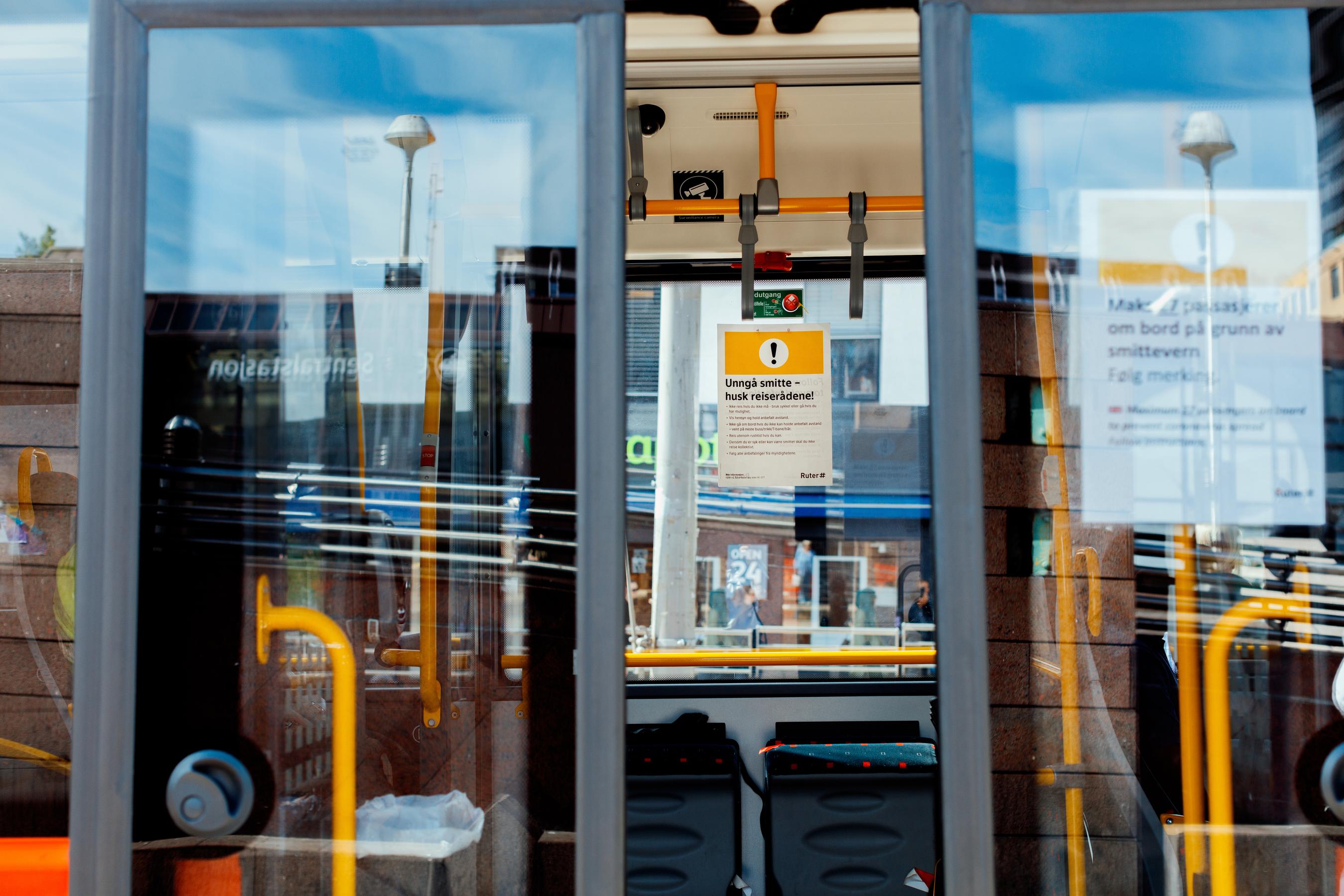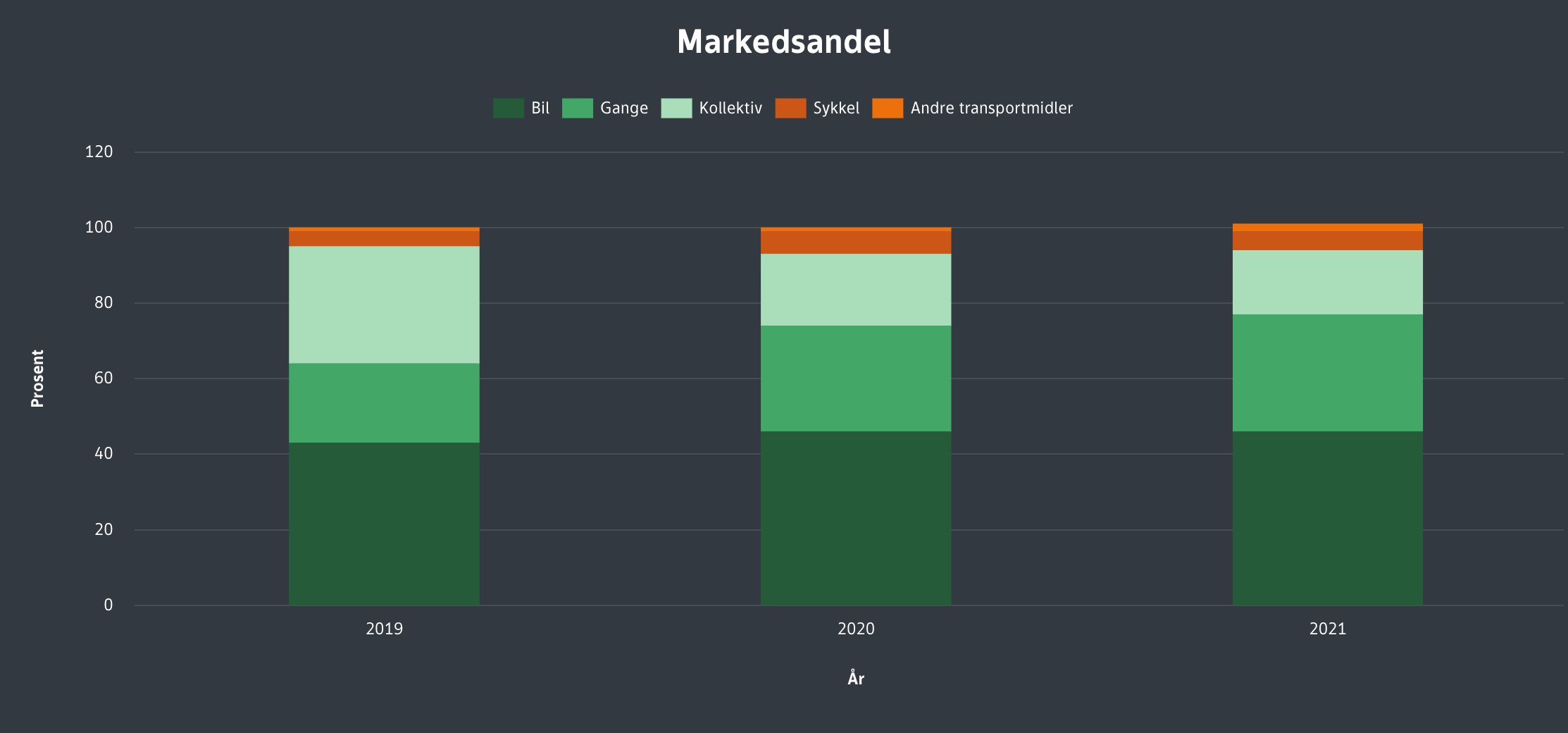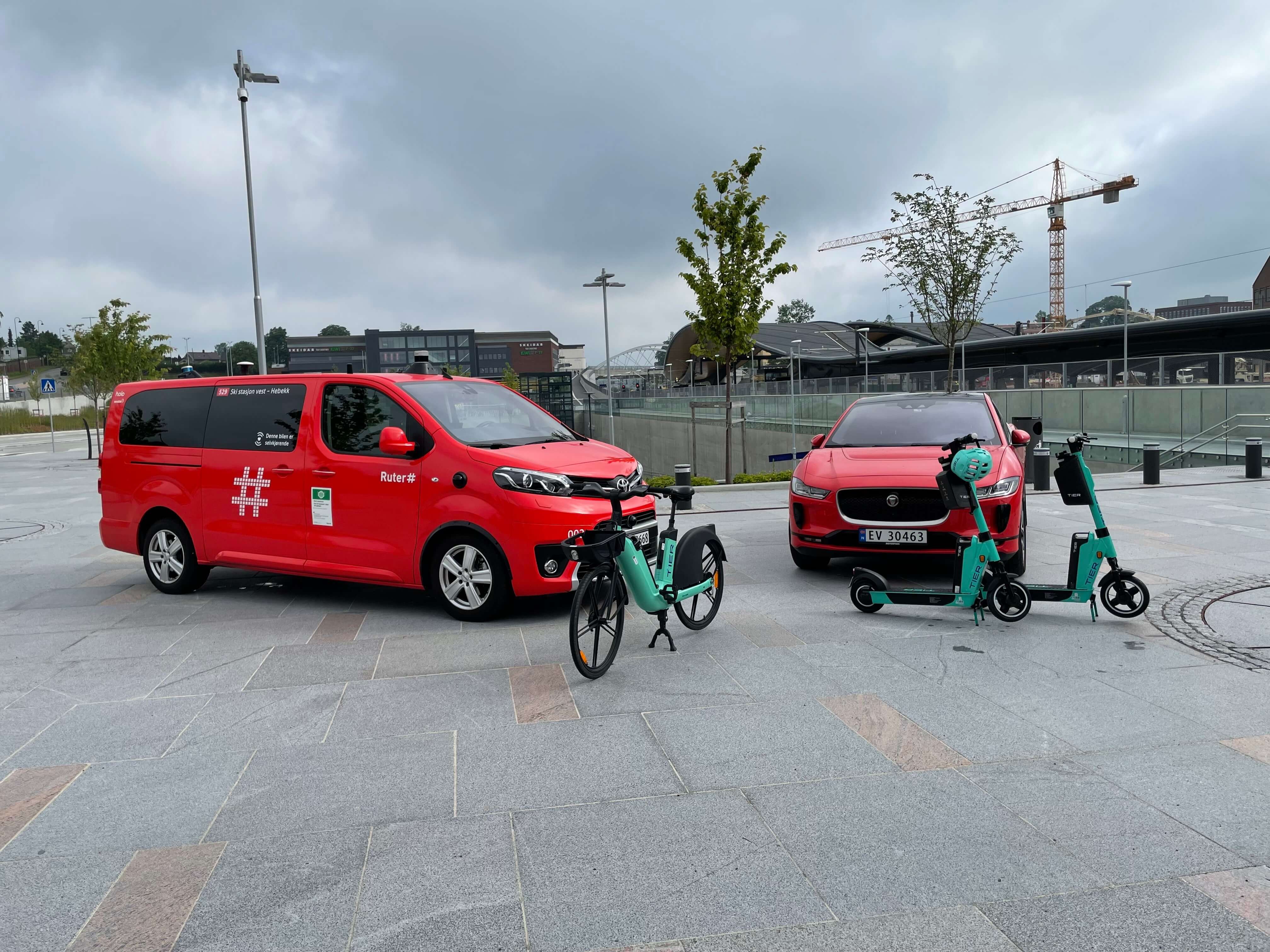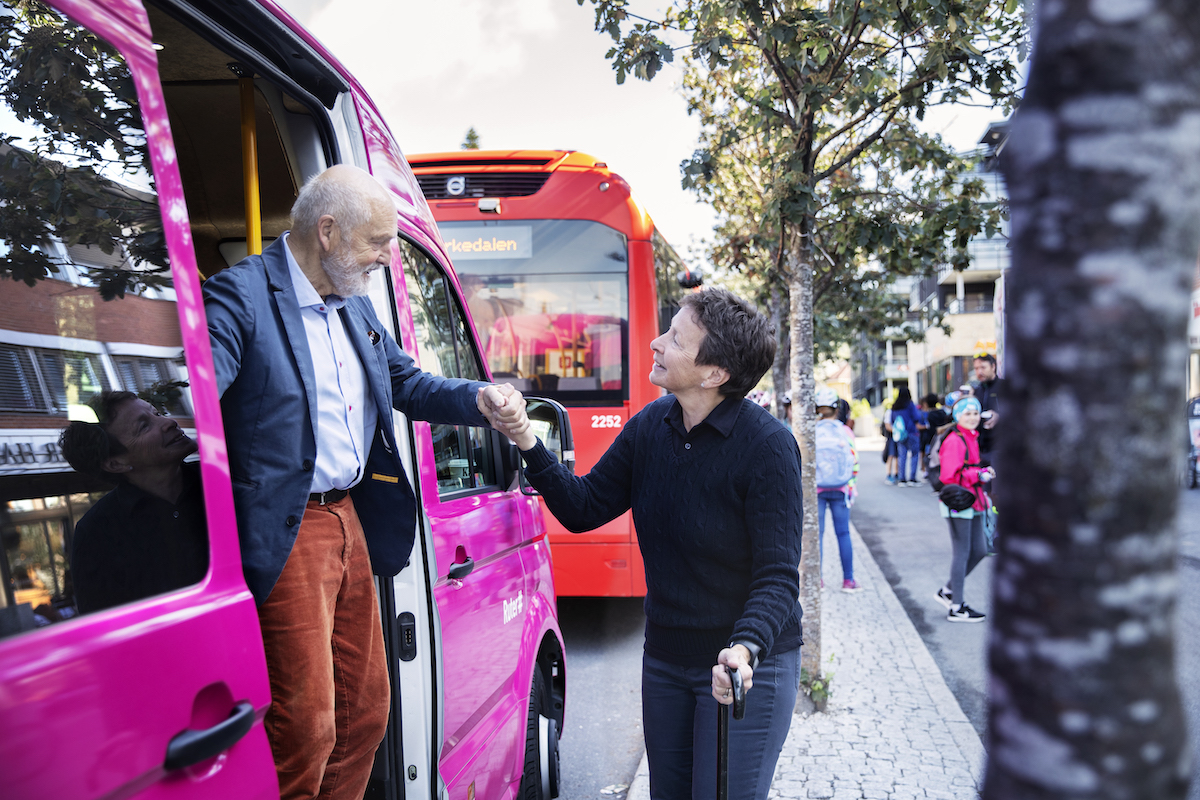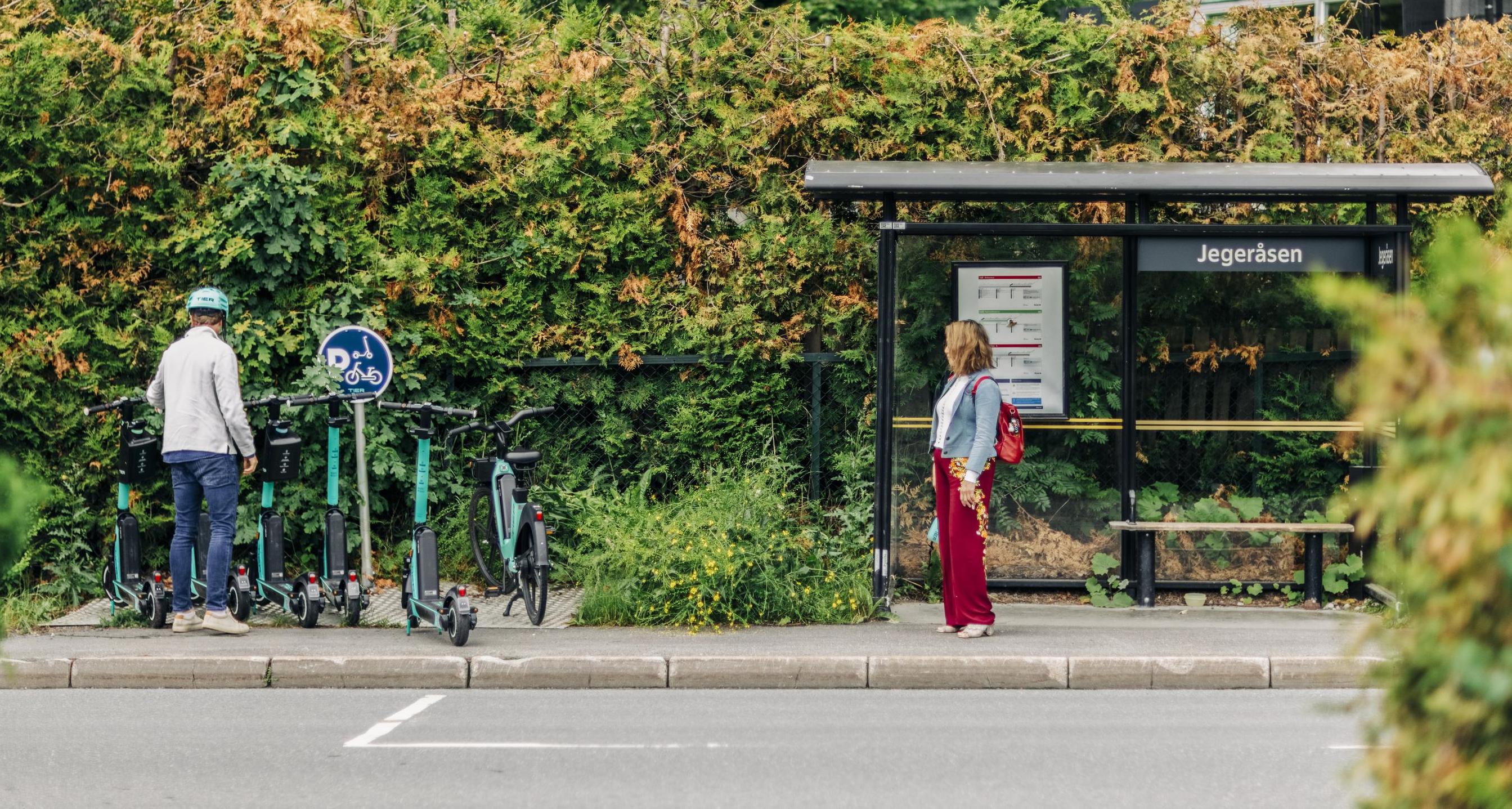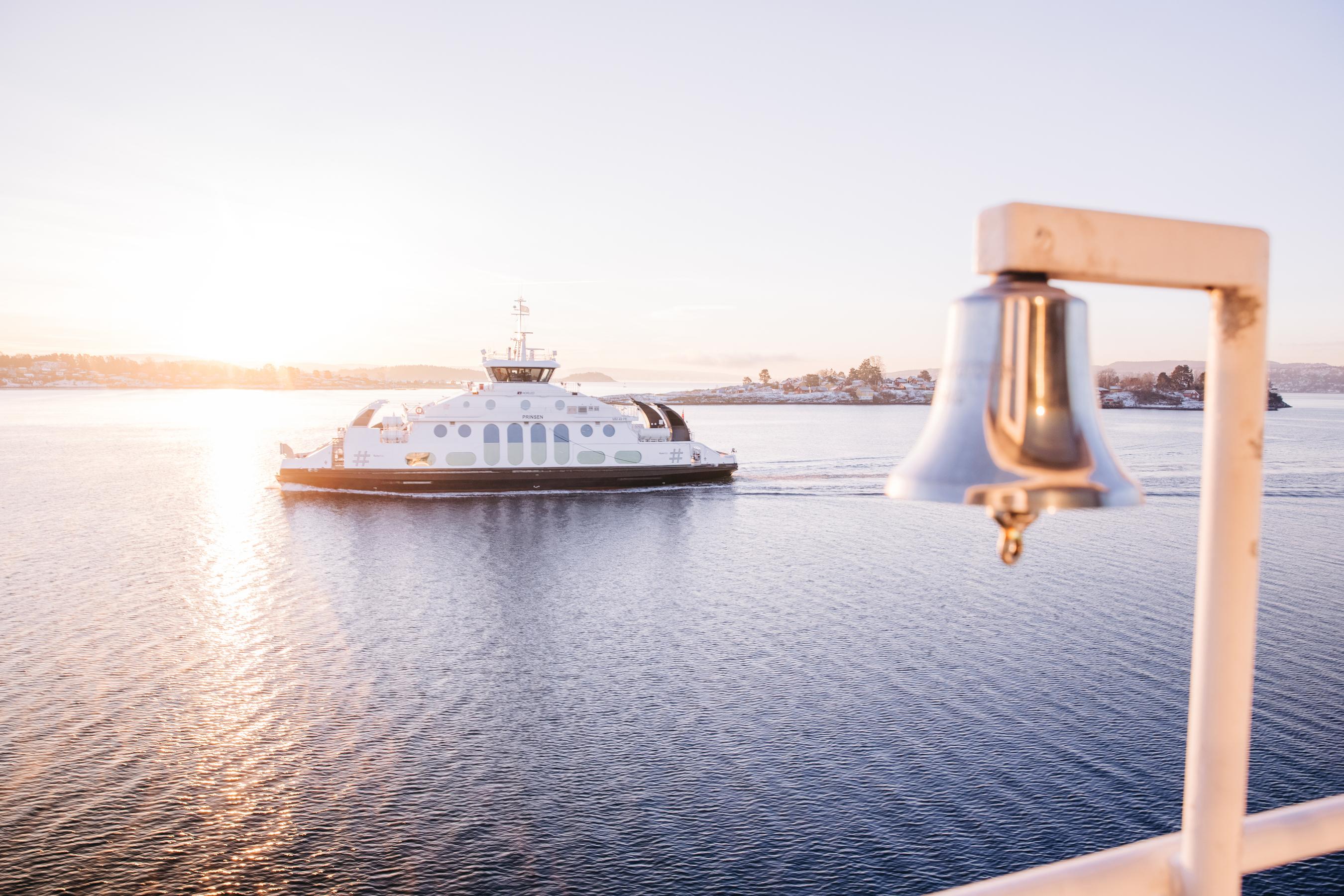
The market
Until the pandemic came along, people were increasingly travelling by public transport in Oslo and in Ruter’s operational area in Viken. At that time, public transport even had a larger market share than the car in Oslo. The pandemic led to major restrictions in the mobility market. As a result of the government encouraging people to travel by car to reduce the spread of infection, fewer people travelled on public transport. When the pandemic is over, Ruter will work to reverse the trend to enable us to achieve regional and national climate goals.
Much of 2021 was similar to 2020: a pandemic travel pattern with fewer journeys and many people working from home. Public transport’s market share was highly dependent on government restrictions. Throughout the year, the number of public transport passengers was between 30 and 70 percent of pre-pandemic levels.
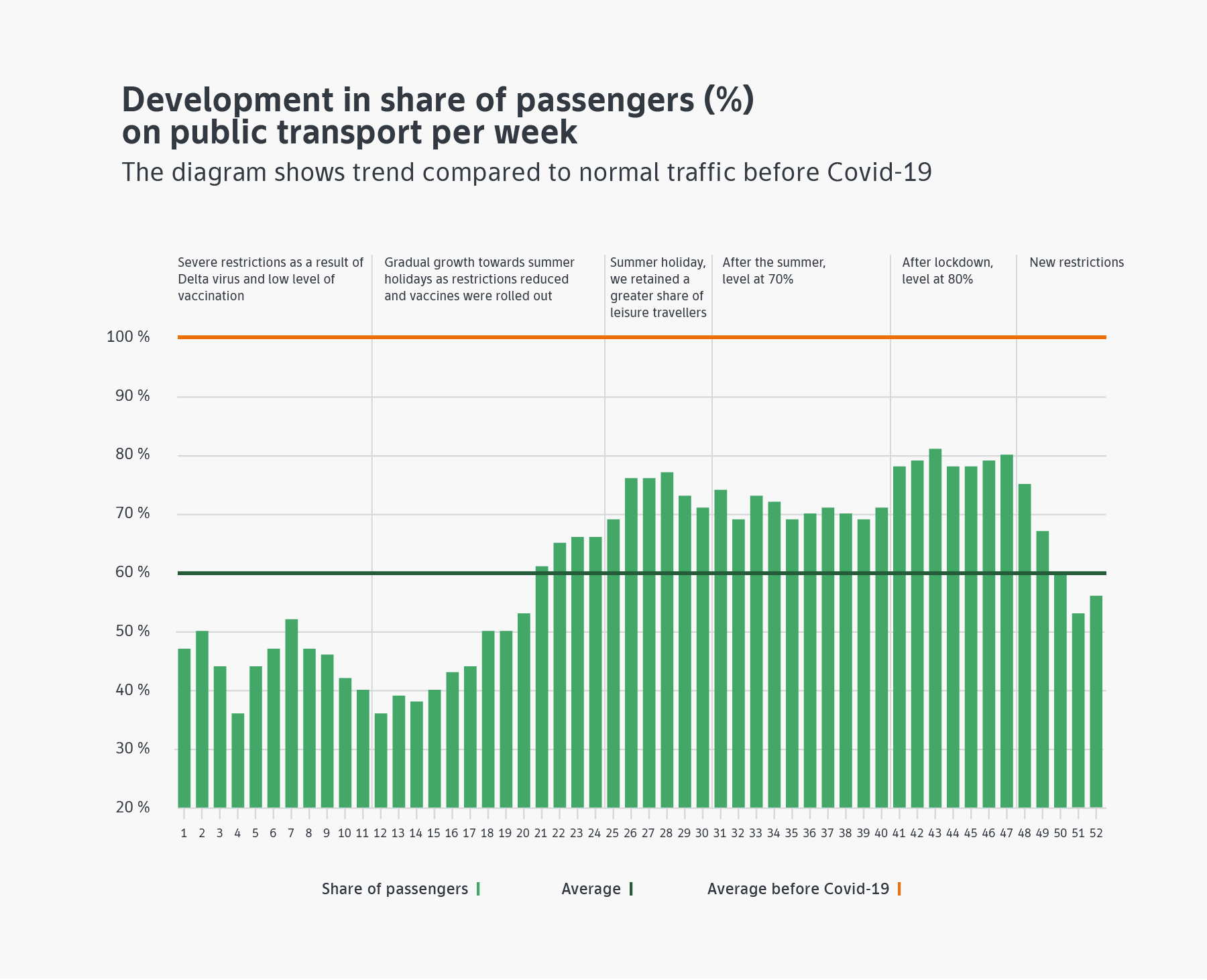
The green forms of mobility are public transport, cycling, walking and micromobility.
During corona restrictions, green forms of mobility such as walking, cycling and electric scooters increased their market share. This was a positive development, but this growth did not replace the large fall in public transport use. This means that the car gained popularity compared to green forms of mobility during the pandemic.
More people using electric cars
Driving became more attractive for several reasons. Firstly, the government’s recommendations not to use public transport made the car a necessary alternative for many. These recommendations probably also affected people’s fear of infection. During the pandemic, the electric car became ‘public property’ and never before were so many new cars registered in Norway. Electric cars have a very low cost of use due to low toll road and parking costs, and the low cost is undoubtedly an important reason why drivers of electric cars use their car more than other drivers do. The growth in the use of electric cars therefore significantly affected the mobility market during the pandemic. This is confirmed by the fact that never before were so many crossings through the toll ring in Oslo recorded.
2021 saw accelerated sales of new cars in Norway. After 35 years, the all-time record for new passenger cars from 1986 was broken. Of 176,276 first-time new cars in 2021, 65 percent were electric cars.
Working from home changed our habits
After two years of working from home, many people missed the interaction and social contact of the workplace. But working from home offered more flexibility and ensured less stress. Working from home is here to stay and will permanently help to reduce the need for commuting.
During the pandemic, as a result of national restrictions, working from home and teleworking became perhaps the most important reason for reduced mobility. We can expect an increase in people working from home even after the pandemic. We saw signs of this when restrictions were lifted in October and November and it once again became possible to commute and work in offices and other workplaces. Many workers still chose to stay at home more than they did before the pandemic. Focus group surveys showed that this provided more flexibility and calm in people’s working lives.
The increased number of people working from home also affected the extent to which the region’s residents attended attractions and utilised opportunities in Central Oslo. Before the pandemic, social activities often took place in extension of working hours near the workplace or in the centre of Oslo. After lockdown, people stated that they now increasingly liked to meet friends at home and/or outdoors and that they generally did not ‘use the city’ to the same extent as before. This meant that both everyday commuting and leisure travel were affected by this shift.
From a market perspective, Ruter wants to achieve the largest possible market share of green journeys, but Ruter does not want to contribute to generating journeys that are unnecessary.
It is therefore important to take into account that working from home has its natural place in the new normal. The question is how many people will be working from home in future and how Ruter should adapt its offering.
The most environmentally friendly journey is the journey that is never taken
Making the population travel as much as possible is not a goal in itself. Neither do we necessarily want to return to the traffic flow as it was before the pandemic. Reducing overall travel activity is good for society. This may lead to lower emissions, less pressure on infrastructure and better accessibility. The goal is to increase green mobility at the expense of car traffic.

Total mobility (the number of daily journeys per person) continued to decline in 2021. This is a sound trend as long as the green forms of mobility make up a larger proportion of all journeys than they did during the pandemic.
Zero growth in passenger transport in metropolitan areas is still the politically agreed goal at national level – and public transport should help to achieve this in combination with cycling and walking. To do this, public transport needs to adapt to the new travel activity normal. It is about facilitating sustainable mobility solutions that have been adapted to new customer needs.

After restrictions were lifted (October and November 2021), 21 percent of the workforce worked from home for at least three days a week. In the ‘new normal’, only 12 percent expect to do the same.
Even in September and October 2021, working from home remained at higher levels than expected in the new normal.
Did we really learn anything about the new normal as restrictions were lifted?
In October and November, we experienced two months in which society gradually reopened. But did it really reopen?
Most infection control restrictions were lifted by the end of September and the need for social distancing was abolished. Society was reopened fully until the beginning of December when infection rates rose again when the Omicron virus was discovered.
During this period, passenger numbers rose from around 70 to 80 percent of 2019 levels. Passenger numbers remained well below previous levels. What does this mean for public transport in the new normal?
Even with two months of gradual reopening in 2021, the pandemic was still around, and we believe that we did not see the return of full demand for public transport in these months. The population also envisioned travelling more on public transport than they actually did. While only 16 percent travelled by public transport 4-7 days a week during the ‘reopening’, 29 percent said that they wanted to travel by public transport 4-7 days a week in the new normal. This makes it clear that we did not reach the full passenger number potential during this period.
One explanation is probably that the pandemic was not over and restrictions remained prohibitive. Both adults and children stayed at home more often as a result of respiratory symptoms than they might have wanted to themselves. Fear of infection and clear guidelines from employers may also have contributed to low passenger numbers. The growth in sales of electric cars also contributed to changing the balance of power between the car and public transport. This can be changed in the new normal situation if the political will exists.

Geographical differences in travel patterns
Ruter has divided the market into four market areas: Inner City (central districts in Oslo), Northeast (Groruddalen and Romerike), West (western districts, Asker and Bærum) and South (southern districts and Follo). In all these market areas, the pandemic and pandemic-related restrictions had a strong impact on the market, but some differences can still be observed.

Central Oslo market area
Central Oslo saw a reduction in use of public transport of 45% compared to 2019. By contrast, walking and use of push-bikes rose exponentially. Mobility in the area was typified by the city being used less both during working hours and for leisure activities – as people were working from home and meeting less outside the home. In Central Oslo, distances are shorter, and it is easier for passengers to alternate between cycling, walking and public transport.
West market area
The West market area is an area in which many residents have higher education, and the percentage of people able to work from home is high. The area also has many early users of electric cars. The percentage of people using public transport fell by about 37% compared to 2019. As the majority wish to work from home – even after the pandemic – many customers in this market area do not see the current ticket portfolio as being sufficiently flexible.
Northeast market area
The Northeast market area has a lower number of employees able to work from home than is the case in the West market area. This has resulted in the market share of public transport falling less in this area (by only 21%). This area is also home to many monthly ticket holders. Monthly ticket holders usually want loyal customers to be recognised for their steady travel patterns in the form of favourable prices on season tickets. An important market effect in North-east is that the electric car has increased its share significantly in the area during the pandemic. North-east has many areas with excellent road capacity, greater distances between points than in the other market areas and relatively low population density. These factors – combined with the low operating costs of electric cars – are expected to have a great effect on the mobility market in the future.
South market area
The South market area saw an overall reduction of use of public transport of about 30% compared to 2019. The market area is, however, divided into several different sub-markets with different travel patterns. Considerable variation exists within the districts that belong to this market area – such as Nordstrand, Søndre Nordstrand and Østensjø – where the areas close to the city centre differ from the more rural surroundings on the outskirts of the City of Oslo. Here we find very high satisfaction with public transport services due to the connection between the bus service and frequent boat departures to both Aker Brygge and Lysaker. There are also similarities between Nesodden and Nordstrand in terms of the high proportion of people who have worked from home, with a corresponding decline in travel activity. For the municipalities that are located further from Oslo – such as Vestby and Enebakk – we see a more limited decline during the pandemic. These municipalities have a lower percentage of inhabitants working in the centre of Oslo, and use of public transport was generally lower before the pandemic than in the other municipalities in the South market area.
Mobility solutions adapted to new customer requirements
Although the effect of corona and the pandemic greatly impacted the mobility market, Ruter also spent 2021 expanding and testing new additions to its mobility offering.
Age-friendly transport was a great success in the districts where it was made available. In 2021, this offering was expanded to the districts of Alna and Bjerke in Groruddalen. It also became possible to travel freely across all districts covered by the scheme (Alna, Bjerke, Nordre Aker, Vestre Aker, Sagene, Ullern and Marka).
In 2021, flexible on-demand transport, which takes customers door to door, was tested in Nes Municipality. Age-friendly transport in Oslo was originally aimed at the elderly, but in October was expanded to include all travellers. As soon as the scheme was opened up to all age groups, passenger numbers on buses increased, and although the scheme is still used mostly by the elderly, we are also seeing a number of younger travellers using it. The pilot provides important insight into how Ruter can offer sustainable freedom of movement in more sparsely populated areas.
Self-drive and mobility point in Ski. On 18 June 2021 we launched the mobility point at Ski Station. By making a number of different means of transport and travel available in one place, we explored different user needs and how new forms of mobility can best be used to complement existing public transport options. In addition to bicycle hotels, kiss & ride, micromobility, car sharing and taxis, we tested self-driving vehicles between Ski Station and Hebekk.
Our first micromobility project was launched in 2019, and the following year we participated in the establishment of a micromobility scheme in Bærum Municipality. We built on this throughout 2021 by expanding our partnership with TIER to Asker, Nordre Follo and Lørenskog Municipalities. In all the projects in which we participate, we investigate needs and uses to identify effective solutions that are adapted to customer, municipality and local requirements.
Satisfaction and reputation in 2021
As in the previous year, travellers in the capital region showed great adaptability to the pandemic and travel restrictions in 2021. Our customers listened to public transport travel advice.
We are very proud of the fact that passenger satisfaction with the public transport system and its reputation remained stable in 2021.
We believe that effective follow-up of infection control measures, better space on board for remaining customers and the maintenance of a stable and reliable offering in uncertain times may be the explanation for steady satisfaction levels during the pandemic.
The statistics section of the Annual Report contains an Excel sheet that breaks down satisfaction and reputation by market area and location.
